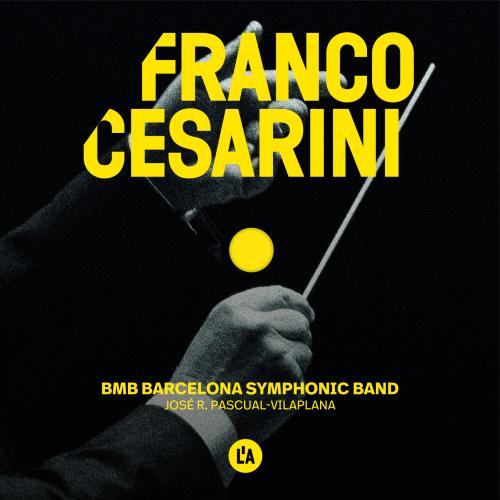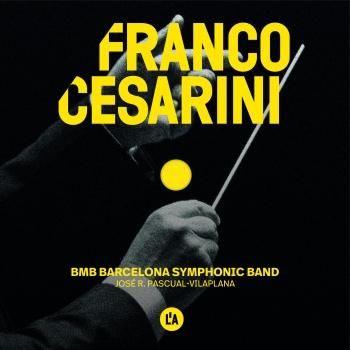
Franco Cesarini: Urban Landscapes Banda Municipal de Barcelona, José R. Pascual-Vilaplana, Franco Cesarini
Album Info
Album Veröffentlichung:
2023
HRA-Veröffentlichung:
09.01.2024
Label: L'Auditori
Genre: Classical
Subgenre: Orchestral
Interpret: Banda Municipal de Barcelona, José R. Pascual-Vilaplana, Franco Cesarini
Komponist: Franco Cesarini (1961)
Das Album enthält Albumcover
- Franco Cesarini (b. 1961): I. Wrigley Building from Dawn to Noon:
- 1 Cesarini: I. Wrigley Building from Dawn to Noon 08:44
- II. Blue Silhouette:
- 2 Cesarini: II. Blue Silhouette 08:14
- III. Cloud Gate:
- 3 Cesarini: III. Cloud Gate 07:50
Info zu Franco Cesarini: Urban Landscapes
Die Barcelona Municipal Band ist eine der ältesten Musikgruppen der Stadt. Es wurde 1886 vom Stadtrat von Barcelona gegründet und ist seit 2007 im Auditorium ansässig, wo es eine stabile Konzertsaison bietet und Projekte in Zusammenarbeit mit nationalen und internationalen Künstlern und Orchestern entwickelt. Seit September 2018 wird es von José R. Pascual-Vilaplana geleitet.
Mit mehr als 130 Jahren Geschichte ist dieses Blasorchester ihren Zielen treu geblieben, ihre Schöpfung zu motivieren, die Musik großer Komponisten der Öffentlichkeit näher zu bringen und qualitativ hochwertige Darbietungen anzubieten. Darüber hinaus konnte es sich an neue Herausforderungen anpassen, indem es auf die Verbreitung des aktuellen Repertoires für Blasorchester setzte, Premieren bei katalanischen Komponisten in Auftrag gibt oder mit heterogenen Künstlern zusammenarbeitet.
Als Teil der neuen und ehrgeizigen künstlerischen Projekte, die vom Auditorium von Barcelona entwickelt wurden, hat die Municipal Band ihr zweites “Künstlerportrait” vorgeschlagen, einen sorgfältigen und genauen Blick auf einen prominenten Musiker. Dieses Jahr war der Schweizer Komponist Franco Cesarini an der Reihe, eine Referenz in der Welt der Blasorchester sowohl in seiner Heimat als auch im Ausland.
Die Uraufführung von Franco Cesarinis Symphony No. 3 “Urban Landscapes”, Op. 55, unter der Regie des Maestro selbst, war natürlich der Höhepunkt des Konzerts. The composition is divided into three movements, which share, cyclically, the same thematic material, which gives the composition a strong cohesion. The first movement, The Wrigley Building from Dawn to Noon, translates into music the awakening of the city, which is slowly coming to life. The sounds of the subway and cars, the sirens of the police and the impromptu melody of a street musician can be heard. In the end, everything explodes in the bright reflection of the sun on the walls of the skyscraper. The second, Blue Silhouette, which includes slow motion and a scherzo, introduces the audience to the nightlife of the metropolis, with the background of the unmistakable rhythms of their jazz clubs. Finally, the third movement, Cloud Gate, starts with powerful fanfares to represent this musically well-known sculpture of the city center. The skyscrapers surrounding it are reflected, distorted, on the silver surface of the monument, popularly called The Bean.
This premiere has been the culmination of a program that opened with The Haunter of the Dark, Op. 17. The piece is based on a tale by the author Howard Phillips Lovecraft (1890-1937) about a deserted church, where according to an old legend a monster had been lying low for years. Franco Cesarini has visited it and sketches the mysterious and occult atmosphere in this composition.
The program was completed by Bulgarian Dances II, Op. 43, composed by Cesarini in 2013. Bulgarian folk music has a long tradition and numerous typical characteristics, such as particular dissonances and complex, irregular rhythms. In this composition, formed by three movements, the composer has preserved the original spirit of Bulgarian folk music.
Banda Municipal de Barcelona
José R. Pascual-Vilaplana, Dirigent
Franco Cesarini, Dirigent
Franco Cesarini
showed since childhood a strong inclination for music. At the age of seven, he joined the children’s choir of Bellinzona (Switzerland), his hometown, where his talent soon established itself: fascinated by the world of sounds, he was able to reproduce the music he heard on the piano, and this before having learned any notion of music. Later it was time to seriously learn an instrument: he took his first steps on the piano, while his passion for the flute was born soon thereafter.
At the age of 11 he attended a concert by flautist Peter-Lukas Graf, which was to be decisive for his future choices. From the very first lessons he revealed a keen interest in understanding the mechanisms that lead to musical creation, remaining enchanted by the works of the great masters. Two composers in particular attracted his attention: Claude Debussy and Béla Bartók. The study of these composers encouraged him to create something on his own. With great enthusiasm he began to devote himself to composition.
At the age of 16, his parents enrolled him at the Giuseppe Verdi Conservatoire in Milan, in piano and flute classes. Over time his passion for the flute took over, and he was admitted into the class of Peter-Lukas Graf at Basel Conservatoire, thus realizing a dream. Intense years of training followed, which saw him simultaneously engaged in his flute studies as well as in conducting and composition studies, progressively graduating in the three subjects.
Franco Cesarini found in his composition teacher, Robert Suter, a demanding personality who knew how to channel his predisposition, integrating it with the necessary writing discipline. His conducting teacher, Felix Hauswirth, introduced him to the fascinating world of wind music. During his studies he won the National Music Performance Competition and, with his Kriegslieder, he won the composition prize “European Year of Music 1985” in addition to winning, for three years in a row, the scholarship of the Ernst Göhner-Migros Foundation. ...
José R. Pascual-Vilaplana
Born on 30th April 1971 in Muro (Alicante) where he began his musical studies with the euphonium and piano in the Unión Musical de Muro, his teachers being Salvador Martínez and Mª Angeles Palacios. Later he continued his professional studies at the Municipal Conservatory of Alcoi and at the Higher Conservatory of Valencia. He studied Band Conducting with the Dutch maestro Jan COBER ("Brabants Conservatorium" in Tilburg) and with the North American conductor Eugene CORPORON (University of North Texas). He studied conducting in Vienna with Karl ÖSTERREICHER, Yuji YUHASA and Hans Graf. He has broadened his knowledge of conducting in various courses with professors such as James Croft, José Collado, Gerardo Pérez Busquier, Norman Milanés and George Pehlivanian. He studied Harmony and Composition with Rafael Alcaraz and Javier Darias.
He has attended Music Pedagogy Courses with the teachers Diego Ramón Lluch, Ana Lucía Frega and Maravillas Díaz at the Escola Comarcal de Música de la Vall d'Albaida.
Since 1988 he has studied band conducting with the Dutch maestro Jan COBER, taking several advanced courses in band conducting with Eugene CORPORON (University of North Texas). In 1993 he was selected for the speciality of Orchestra Conducting at the "Wiener Musikseminar" in Vienna, studying with Karl ÖSTERREICHER and Yuji YUHASA. In 1994 he attended James CROFT's conducting classes in Chicago at the 47th Mid West Band and Orchestra Clinic. Mid West Band and Orchestra Clinic".
In 1995 he obtained the Conducting Diploma of the "Wiener Meisterkurse für Musik" at the Musikhochschule Wien with Hans GRAF. He has broadened his knowledge of conducting in various courses with professors such as José Collado, Gerardo Pérez Busquier, Norman Milanés and Georges Pehlivanian.
Dieses Album enthält kein Booklet










